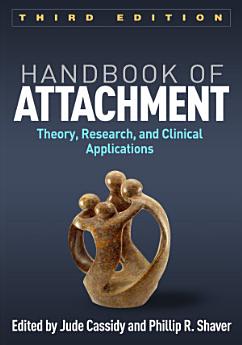Handbook of Attachment: Theory, Research, and Clinical Applications, Edition 3
Jude Cassidy · Phillip R. Shaver
May 2016 · Guilford Publications
5.0star
1 reviewreport
Ebook
1068
Pages
family_home
Eligible
info
reportRatings and reviews aren’t verified Learn More
About this ebook
Widely regarded as the state-of-the-science reference on attachment, this handbook interweaves theory and cutting-edge research with clinical applications. Leading researchers examine the origins and development of attachment theory; present biological and evolutionary perspectives; and explore the role of attachment processes in relationships, including both parent–child and romantic bonds. Implications for mental health and psychotherapy are addressed, with reviews of exemplary attachment-oriented interventions for children and adolescents, adults, couples, and families. Contributors discuss best practices in assessment and critically evaluate available instruments and protocols.
New to This Edition
New to This Edition
- Chapters on genetics and epigenetics, psychoneuroimmunology, and sexual mating.
- Chapters on compassion, school readiness, and the caregiving system across the lifespan.
- Chapter probing the relation between attachment and other developmental influences.
- Nearly a decade's worth of theoretical and empirical advances.
Ratings and reviews
5.0
1 review
About the author
Jude Cassidy, PhD, is Distinguished Scholar-Teacher and Professor of Psychology at the University of Maryland, College Park, and Director of the Maryland Child and Family Development Laboratory. Her research interests include socioemotional development from infancy through adolescence, with an emphasis on attachment and family relationships; social, cognitive, and regulatory mechanisms through which children’s early family experiences come to influence later well-being and relationships; and early intervention designed to reduce the risk of insecure attachment and mental disorders. Her research has been funded by the National Institute of Mental Health, the National Institute of Child Health and Human Development, the National Institute on Drug Abuse, the Substance Abuse and Mental Health Services Administration, and the Zanvyl and Isabelle Krieger Fund. Dr. Cassidy serves as coeditor of the journal Attachment and Human Development and is on the editorial boards of Journal of Clinical Child and Adolescent Psychology and Infant Mental Health Journal. She is a Fellow of the Association for Psychological Science and the American Psychological Association (APA), and received the Boyd R. McCandless Young Scientist Award from APA Division 7 (Developmental Psychology).
Phillip R. Shaver, PhD, is Distinguished Professor Emeritus of Psychology at the University of California, Davis. He has published numerous books, including Handbook of Attachment, and over 400 journal articles and book chapters. Dr. Shaver’s research focuses on attachment, human motivation and emotion, close relationships, personality development, and the effects of meditation on behavior and brain. He is a Fellow of the American Psychological Association and the Association for Psychological Science and is past president of the International Association for Relationship Research, from which he received the Distinguished Career Award. He has also received an honorary doctorate from Stockholm University and Distinguished Career Awards from the Society of Experimental Social Psychology and the Society for Personality and Social Psychology. He is an elected member of the American Academy of Arts and Sciences.
Phillip R. Shaver, PhD, is Distinguished Professor Emeritus of Psychology at the University of California, Davis. He has published numerous books, including Handbook of Attachment, and over 400 journal articles and book chapters. Dr. Shaver’s research focuses on attachment, human motivation and emotion, close relationships, personality development, and the effects of meditation on behavior and brain. He is a Fellow of the American Psychological Association and the Association for Psychological Science and is past president of the International Association for Relationship Research, from which he received the Distinguished Career Award. He has also received an honorary doctorate from Stockholm University and Distinguished Career Awards from the Society of Experimental Social Psychology and the Society for Personality and Social Psychology. He is an elected member of the American Academy of Arts and Sciences.
Rate this ebook
Tell us what you think.
Reading information
Smartphones and tablets
Install the Google Play Books app for Android and iPad/iPhone. It syncs automatically with your account and allows you to read online or offline wherever you are.
Laptops and computers
You can listen to audiobooks purchased on Google Play using your computer's web browser.
eReaders and other devices
To read on e-ink devices like Kobo eReaders, you'll need to download a file and transfer it to your device. Follow the detailed Help Center instructions to transfer the files to supported eReaders.





